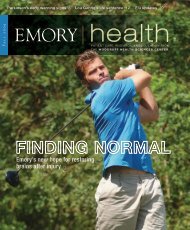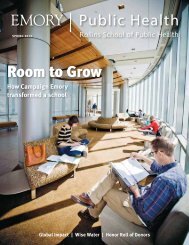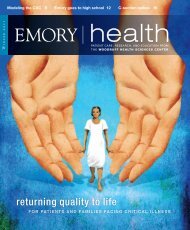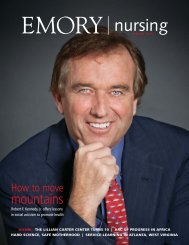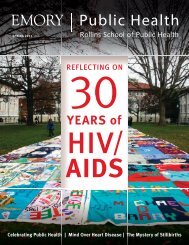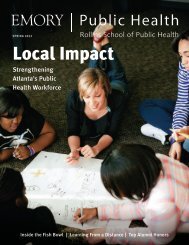nursing - Woodruff Health Sciences Center - Emory University
nursing - Woodruff Health Sciences Center - Emory University
nursing - Woodruff Health Sciences Center - Emory University
Create successful ePaper yourself
Turn your PDF publications into a flip-book with our unique Google optimized e-Paper software.
EMERGENCY NURSING AT EMORY AND GRADY<br />
True Grit<br />
NP program fills void in emergency care<br />
Dian Dowling Evans<br />
90MN (right) works<br />
in the ED at <strong>Emory</strong><br />
<strong>University</strong> Hospital,<br />
where clinical nurse<br />
specialist Ariel<br />
Morris 10MN (left)<br />
trained to become<br />
an emergency nurse<br />
practitioner.<br />
“The ability to communicate<br />
well and work as a team is<br />
critical.”<br />
—Dian Dowling Evans<br />
Emergency Nurse Practitioner Program<br />
12 <strong>Emory</strong> Nursing WINTER 2011<br />
It’s 3:30 on a Friday afternoon, and already the hallways<br />
are lined with gurneys and patients. Registered<br />
nurse Ali McCray 10MN 12MPH walks around the<br />
blue zone of Grady Memorial Hospital’s emergency<br />
department (ED), looking for her first patient, a<br />
young man with testicular pain. McCray takes the<br />
man’s vitals and a case history, recording the information<br />
on a little black notepad before heading off<br />
to review the case with her preceptor, a second-year<br />
physician resident. She will repeat this scenario many<br />
times over before the end<br />
of her shift. Seventy-three<br />
patients are waiting in the<br />
lobby, and more are sure to<br />
come as the weekend kicks<br />
into high gear.<br />
McCray’s shift is part of<br />
the clinical rotation required<br />
by <strong>Emory</strong>’s emergency nurse<br />
practitioner (ENP) program.<br />
It is one of only seven in the<br />
nation designed to put nurse practitioners into U.S.<br />
trauma centers and EDs. And it is the only program<br />
that formally trains nurse practitioners with emer-<br />
gency medicine physician residents in a specially<br />
designed interdisciplinary clinical rotation.<br />
“There is a serious national shortage of board-certified<br />
emergency medicine physicians to adequately<br />
staff existing EDs 24/7 across the country,” says Dian<br />
Dowling Evans 90MN, who directs the school’s ENP<br />
program and works in the ED at <strong>Emory</strong> <strong>University</strong><br />
Hospital. “Nurse practitioners have become important<br />
players in helping address the ED provider<br />
shortage, which means that emergency physicians<br />
will probably work with an ENP at some point in<br />
their careers. Training NPs with emergency medicine<br />
residents is one way that <strong>Emory</strong> is helping prepare<br />
future ED providers to better understand how to<br />
work together to optimize emergency care.”<br />
ENPs have been around since the 1970s but now<br />
are more common as hospitals seek less expensive<br />
ways to address the many patients who use EDs for<br />
primary health care. Between 1997 and 2007, the<br />
number of NPs working in EDs more than doubled,<br />
according to an article in the October 2009 Journal<br />
of Academic Emergency Medicine.<br />
Like other types of nurse practitioners, ENPs<br />
are schooled in primary care. But they also learn<br />
advanced cardiac life support, central line insertion,<br />
advanced wound repair, and emergency births, and<br />
they complete 700 hours of clinical rotations. Not<br />
only do students work in the EDs at <strong>Emory</strong> <strong>University</strong><br />
Hospital, <strong>Emory</strong> <strong>University</strong> Hospital Midtown,<br />
and Grady Hospital, but they also spend time in<br />
the orthopaedics, dermatology, ophthalmology, and<br />
surgery departments at Grady. These shifts expose<br />
students to some of the most common complaints of<br />
emergency patients—broken bones, sprained muscles,<br />
skin rashes, and eye infections.<br />
Rotations also give nurses a taste of the pace and<br />
demands of working in an emergency department.<br />
“It’s not a 9-to-5 job,” Dowling Evans says. “It’s<br />
stressful. You need to be assertive. You must be willing<br />
to care for some of the sickest and most vulnerable<br />
patients. You have to be efficient and willing<br />
to make critical decisions fast. You also have to be<br />
gritty. You can’t get your feelings hurt. When people<br />
are in the ED, you have a short time to establish a<br />
relationship of compassion and understanding. The<br />
ability to communicate well and work as a team is<br />
critical.”—Kay Torrance



